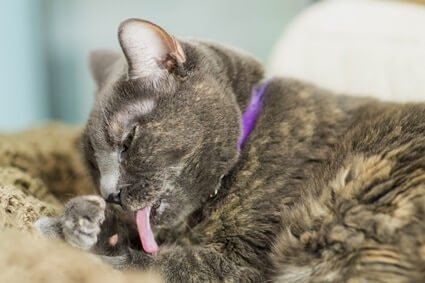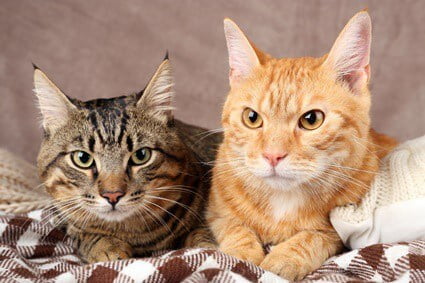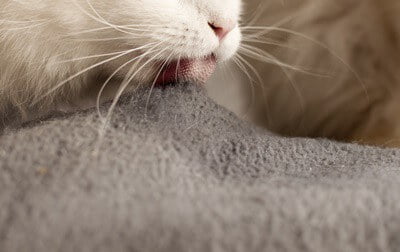Cat owners spend hours watching their pets, equally entertained and bemused by their behavior. Cats have many quirky habits, but among the most notable is kneading and sucking on blankets.
Felines have scent glands in their paws. This means they can claim the blanket as their territory by kneading it. Also, kittens knead their mother’s nipples to release milk. If your cat is sucking on the blanket while kneading, it’s a form of comforting behavior.
Cats display unique behaviors around blankets that make little sense to humans. If you’ve ever wondered what your cat is thinking while purring contentedly in bed, then things will soon become clearer.
Why Does My Cat Knead and Suck on Its Blanket?
If your cat kneads its blanket, it’s marking the item as its own. This is achieved through the glands found in the paws. This is where a cat sweats when it starts to overheat.
As a result, the paws release a unique scent. During the process, the cat feels entirely contented and relaxed. You’ll often find your cat purring while kneading, as it’s a sign of happiness in cats.
Laying claim to blankets is common in multi-cat households as cats often have a preferred sleeping spot. If one of your cats kneads the blanket on the radiator or by the window, it’s warning off other pets. Your cat is ensuring that the blanket is available whenever it wants it.
Kneading a blanket while suckling is a little different. Think of this behavior as being similar to a child sucking their thumb. Cats cannot do that, and neither are they able to suckle on a pacifier.
By kneading and suckling a blanket, it can replicate the feeding experience of its kittenhood. This will be comforting and calming for a cat. It’s most notable in cats that were separated from their mothers too soon.
Cats are likely to knead and suckle a blanket that’s fresh from the laundry dryer. The warmth is a comforting reminder of the feeding sensation.
Should I Be Concerned?
A cat will likely knead blankets throughout its life, which is a natural feline behavior that’s fun and functional. Just be careful about allowing your cat to knead.
Your cat may relax in your lap and start kneading to demonstrate affection and contentment. It doesn’t realize that its claws can become painful if they dig into human skin.
In isolation, sucking on blankets is also nothing to worry about. Seeking comfort doesn’t mean that your cat is anxious or unhappy.
Don’t let your cat repeat this process with anything dangerous. Some cats may attempt to suck shoelaces and shopping bags, leaving them at risk of swallowing plastic and string-like materials.

Also, be aware that most cats outgrow suckling behavior after the second year of their life. That’s not to say that an adult cat will never do it again, just that it’ll become a less frequent habit.
If your cat sucks blankets while overeating and playing, it suggests an anxiety disorder. As cats don’t enjoy expressing vulnerability, they won’t seek human assistance to deal with this issue.
Instead, they prefer to self-soothe. Again, if this happens occasionally, it’s fine. It may be a psychological issue if it’s constant and at the expense of all other daily activities.
Should I Stop My Cat?
If you’re determined to stop your cat from sucking a blanket, it can be trained. This could take the form of a very mild form of chastisement.
Applying something foul-tasting or smelling to the blanket may deter sucking. Lemon or lime juices work because cats hate the smell of citrus.
This is likely to cause your cat stress and anxiety, so it’s not recommended. Forcing a cat to go cold turkey can be traumatic, which may lead to them acting aggressively as they struggle to manage their emotions.
If you must wean your cat off a blanket, offer it a substitute. An old wool sweater that smells like you is ideal, and your cat will draw comfort from your scent, while the wool will feel safe.
Why Does My Cat Lick My Blanket and Purr?
Another common question for a feline owner is, why do cats lick fur blankets? Usually, this is a sign of affection. Cats lick and groom each other to demonstrate that they’re part of a family. Your cat will also lick you for the same reason.
If your cat is licking a blanket and purring, it’s happy and contented. This suggests that that blanket has a comforting and familiar scent. This may be of you, or it could be a feline companion. Either way, it’s sparking happy associations in your cat’s mind.
You may find that your cat jumps into your lap and licks your clothing. This behavior has the same roots as licking a blanket. Your cat is picking up on your scent, making it feel safe and secure. If your cat licks blankets or dirty laundry, you shouldn’t necessarily deter them.
Why Do Cats Bite Blankets?
Biting a blanket is common in kittens, as that’s how they play. According to Science Direct, young cats learn how hard they can nibble and bite from their mothers and littermates.
Like sucking, constant biting may signify that a cat was separated from its mother sooner than it would have liked. It may be expecting the blanket to respond in some way.
Even as cats grow up, they’ll continue to do this. Male cats, in particular, associate biting with pleasure. This is because they gently bite the neck of a female while mating. Biting and chewing are also fun and relaxing for cats.
You may notice your cat almost entering a trance-like state while biting, eventually falling into a deep sleep. If you don’t want your cat biting a blanket, offer it dog toys. These are usually bigger and sturdier than cat toys, and they’ll give your cat something to sink its teeth into.
Also, think back to how biting and sucking blankets simulates feeding on their mother for cats. If a kitten is struggling to feed, it may bite in frustration like a breastfeeding child.
If it feels that the blanket should be providing food, they’ll get fed up when it doesn’t. Like most behaviors associated with kittens, this should pass before your cat reaches 3.
You should monitor your cat’s oral health. A cat showing signs of gum disease or tooth decay will be in some pain.
Chewing and biting the blanket could be an attempt to ease its discomfort. A vet should see any health concerns related to teeth or gums.
Why Do Cats Like Wool?
It’s a common cliché that cats enjoy chasing balls of wool, and this sparks their hunting instincts. It’s like an organic laser pointer or chasing after a piece of string. As discussed, cats chewing on static wool may be a form of kneading and suckling behavior.
Wool is soft and comforting. This will mean that a cat will enjoy sucking and kneading a blanket or wool rug. However, there may be a medical condition that encourages this behavior.
According to the BSAVA Manual of Feline Practice, pica is a psychological condition that results in a desire to eat non-food items. If your cat moves from kneading and sucking a blanket to eating the blanket, this poses health risks.
Your cat may end up blocking its digestive tract or choking. If your cat is trying to eat wool, it may be lacking essential nutrients elsewhere.

Another reason a cat may be drawn to wool is that they lack stimulation. Cats like to chew for entertainment, even after outgrowing the teething phase, and that’s why so many cat toys are chewable.
If your cat has started to chew wool, you should play with it more and ensure that it gets more exercise. It might be frustrated with being an indoor cat if it had previously wandered the neighborhood at will.
Chewing is a favorite way of passing the time. If your cat has things to keep it occupied, it’s far less likely to resort to chewing.
In some cases, your cat may have a feline form of OCD. This is particularly likely if your cat is anxious or nervous. Your cat may be drawing comfort from wool as it holds familiar scents.
Can a Cat Be Allergic to Material?
It’s common for cats to be allergic to the material used to make a blanket. Fabrics are a common cause of allergies.
Common symptoms of an allergic reaction in a cat include:
- Coughing, sneezing, and wheezing
- Itchy and streaming eyes
- Itchy skin, ears, and tail
- Vomiting and diarrhea
- Swollen paws and paw pads
If your cat shows these symptoms, remove the blanket and replace it with something else. This could be a different type of fabric or a comforting item.
If your cat seems content while kneading and sucking on blankets, leave it to it. This is your cat’s happy place, and it’ll be feeling contented.
Likewise, it may just be claiming the blanket as its own as cats are territorial creatures. If all but one of your cats avoid a certain blanket, you now know why that’s the case.

